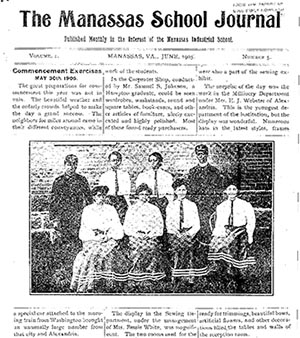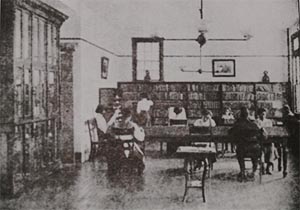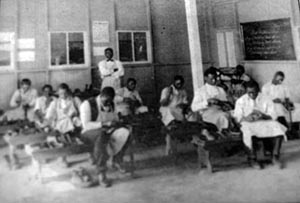Curriculum
Mixed Curriculum
The curriculum at the Manassas Industrial School was a mix of vocational and liberal arts education. Despite the fact that it was a mixed curriculum it was heavily weighted towards the liberal arts side of the spectrum.  Manassas School Journal 1905
Manassas School Journal 1905
Emily Howland Papers-Cornell Unlike the large industrial schools like Hampton-Tuskegee, MIS did not over emphasize the role of the vocational aspects of the curriculum. This seems to be part of the concerns of the African American community when they were protesting against the ideas of Villard and his supporters. Jenkins writes, “Practical training in agriculture and the industrial arts best matched the intellectual capabilities and peculiararities of black Americans, white paternalists believed; cultural and liberal education made no sense.” What we see in contrast to this idea is that a cultural and liberal education did make sense to the Black community. >
Weekly Studies
First Year
The curriculum of the school consisted of 20 hours per week of required courses which were academic in nature and only 45 minutes per week was required towards trades for the first year student. Eighteen additional hours of supervised study were required, which appears to have been electives, and another 2 hours of military training/physical education were required per week. Academic courses consisted of American History, Arithmetic, Botany, Chemistry, Geography, Language, Physiology, and Reading.
Second Year
During the second year everything remains basically the same with the exception of a one hour increase in required academic courses and a one hour decline in supervised study. 
Manassas Industrial School Library
Manassas Museum
The academic courses now are American History, Agronomy, Arithmetic, Botany, Civics, Grammar, Literature, and Physiology.
Third Year
The third year marked a significant change in the nature of the courses. We begin to see less of the rudimentary courses and more of a trend towards “true” liberal arts training. A third year student had no requirement to take vocational courses, except for women who were expected to take two and a half hours per week of “Household Arts.” Although it was possible for students to take a trade class in their electives it was not mandatory. Boys took a class called Farm Management instead. In addition, third year students were now required to take Algebra, Accounting, History of Education, Literature and Physics to name a few of the academic courses. By the time a student began the fourth year of their instruction at MIS they had received a pretty through liberal arts education.
Fourth Year
The fourth year greatly resembled the third with the notable additions of Composition and Rhetoric, English History, History of Literature, Psychology, Sociology, a methods course in education, and three months of student teaching.
Teacher Training
After looking at this slate of coursework it appears that this was geared more toward liberal arts education and as a curriculum geared toward future teachers instead of farmers or blacksmiths. Nevertheless this course of study was not the only one that a student could choose. Surprisingly the trades track had a curriculum that was almost exactly like the academic program with the exception of the teacher training courses and the lack of electives.  Shoemaking and Repair Class-
Shoemaking and Repair Class-
Manassas Industrial School
Manassas Museum Instead of electives, the student following the trades curriculum was required to work in the particular area that he or she was studying whether that was blacksmithing, carpentry, matress making, shoemaking, wheel wrighting or home economics. Students were still expected to take a set number, still a majority of their total time, of academic courses in order to receive their diploma.
Paradox
This seems to be paradoxical. The Manassas Industrial School was a school whose stated mission was to provide vocational training to the members of the African American community. If this was the case, then we are left wondering why there was such a large proportion of time devoted towards academic study rather than simply training students in their trades and releasing them into the workplace. Instead there was the unnecessary delay of two years or perhaps more that was the result of these additional course requirements. The answer seems to be that the African American community demanded more than a simple vocational education.
(Back to top)NEXT
